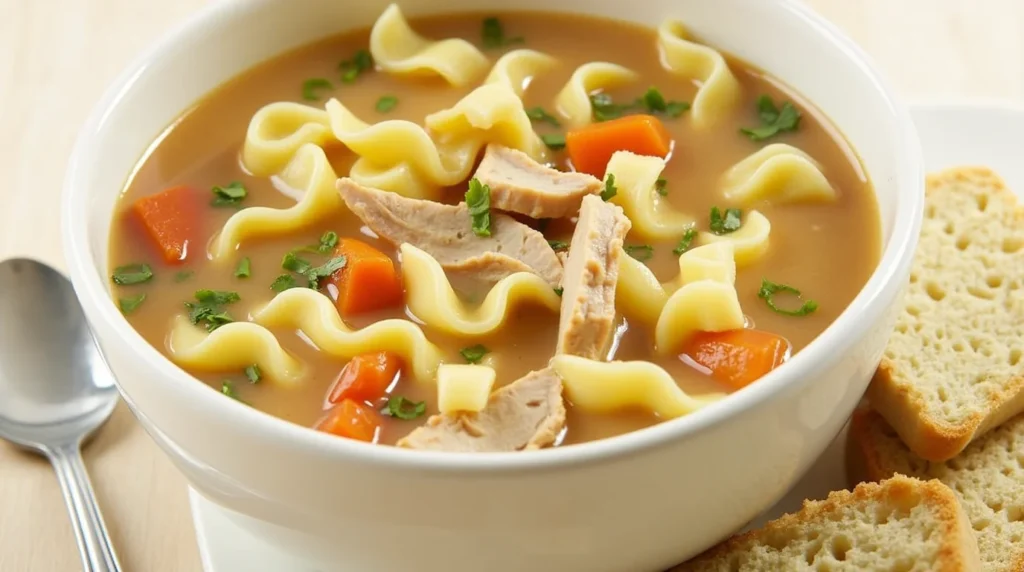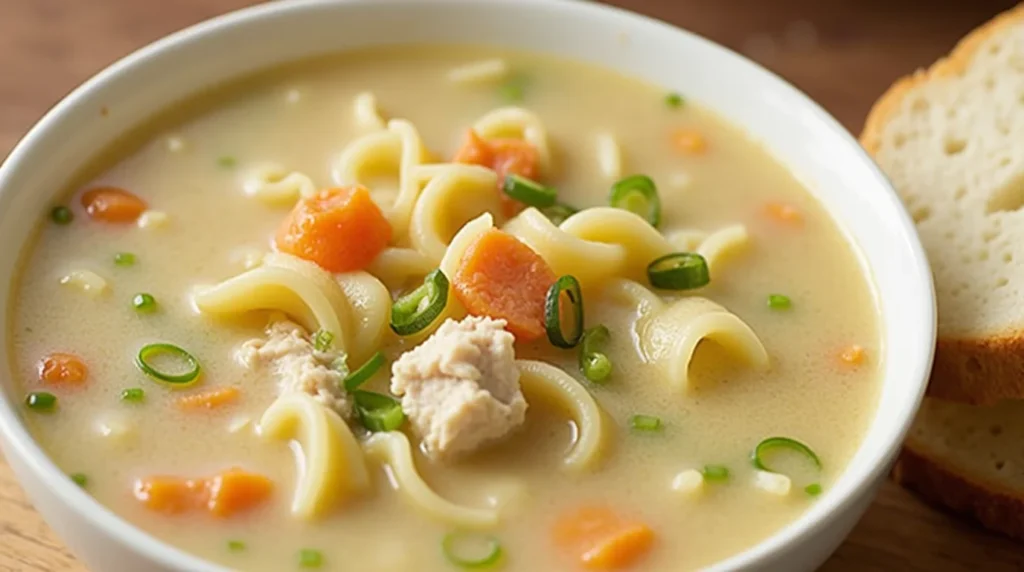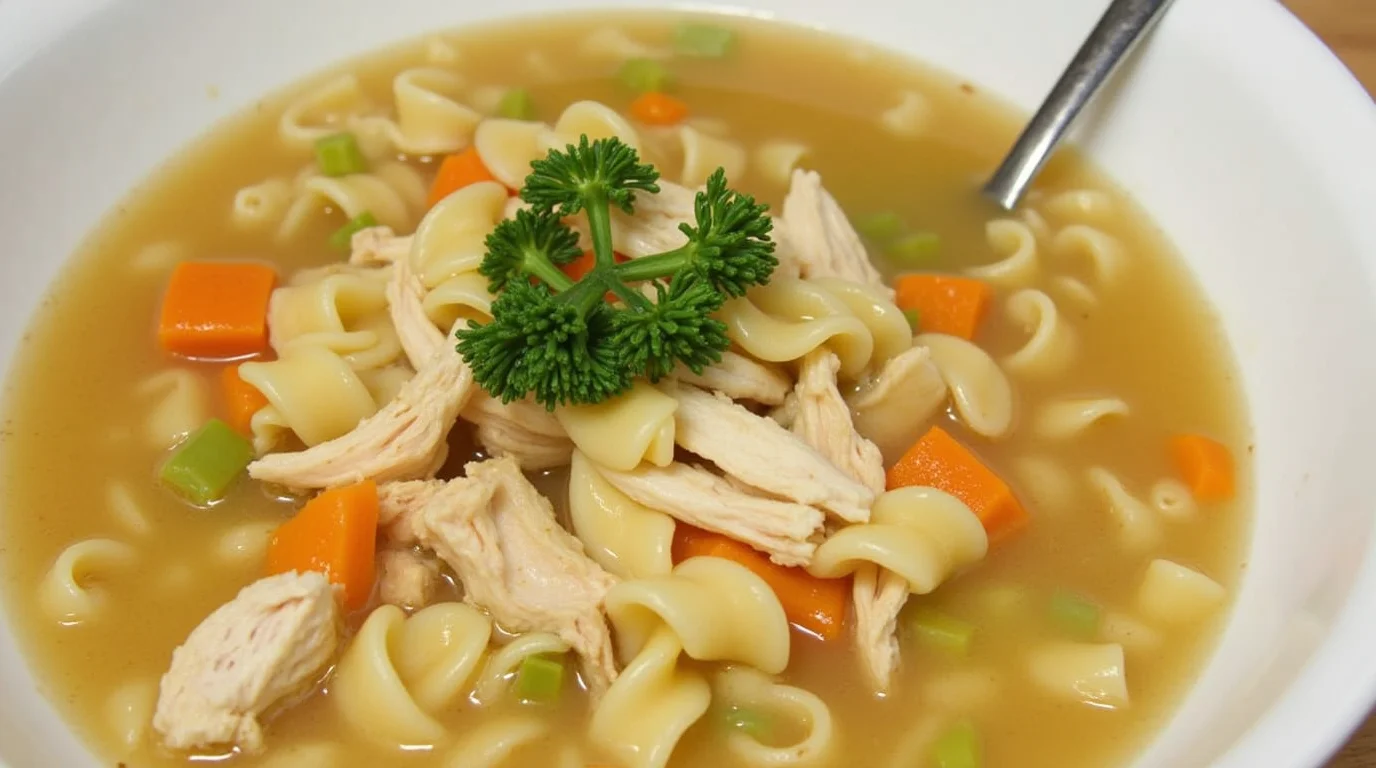Chicken noodle soup has a rich history that dates back centuries, cherished as a nourishing dish across cultures. Its roots can be traced to ancient times when people combined simple ingredients like chicken, vegetables, and broth to create a hearty meal. Over time, it evolved into a universal comfort food, loved for its warmth and simplicity.
Across the globe, chicken noodle soup has become synonymous with care and healing, often served to soothe colds, flu, or a weary soul. Whether it’s a steaming bowl of American-style soup, a flavorful Asian variation, or a Mediterranean twist, its versatility is unmatched.
Beyond its delicious taste, chicken noodle soup boasts numerous health benefits. Packed with protein, vitamins, and minerals, it supports the immune system and promotes overall well-being. This iconic dish is more than food—it’s a heartfelt reminder of home, tradition, and the power of a comforting meal.

Ingredients Overview: The Building Blocks of Chicken Noodle Soup
Crafting the perfect bowl of chicken noodle soup begins with understanding its key components. This iconic dish is simple yet flavorful, relying on a harmonious combination of fresh ingredients that create a comforting experience.
Key Components of Chicken Noodle Soup
To make an unforgettable chicken noodle soup, these ingredients are essential:
- Chicken: The heart of the soup, providing protein and depth of flavor. Opt for bone-in chicken for a richer broth.
- Noodles: Traditional egg noodles are popular, but options like gluten-free noodles or whole-wheat varieties cater to dietary needs.
- Vegetables: Classic choices include carrots, celery, and onions, which add sweetness and texture.
- Broth: A well-seasoned chicken broth or stock serves as the foundation. For a healthier twist, consider using low-sodium broth.
The Importance of Fresh Ingredients
Using fresh, high-quality ingredients elevates the taste and nutritional value of chicken noodle soup. Fresh vegetables retain their vibrant flavor and crunch, while a homemade broth imparts a depth that store-bought versions often lack. For tips on choosing the best noodles for soup, explore Bon Appétit’s guide.
Variations in Ingredients
What makes chicken noodle soup so versatile is its adaptability to various preferences and dietary restrictions:
- Gluten-Free Options: Substitute traditional noodles with gluten-free varieties like rice noodles or zucchini spirals.
- Low-Sodium Choices: Opt for low-sodium chicken broth to keep the dish heart-healthy without compromising flavor.
- Protein Variations: Swap chicken for turkey or tofu for a plant-based alternative.
Experiment with fresh herbs, spices, or lemon juice to customize the flavor profile. For more health-conscious ingredient swaps, check out Healthline’s guide to chicken broth benefits.
By mastering the basics and experimenting with these variations, you’ll create a bowl of chicken noodle soup that is both nourishing and irresistibly delicious.

Step-by-Step Guide to Making Chicken Noodle Soup
Creating the perfect bowl of chicken noodle soup is a delightful process that blends simple ingredients into a heartwarming dish. Follow this step-by-step guide to ensure your soup is packed with flavor, texture, and comfort.
Step 1: Preparing the Chicken
The foundation of any great chicken noodle soup is tender, flavorful chicken.
- Choose the right cut: Bone-in, skin-on chicken thighs or breasts are ideal for creating a rich broth.
- Cook the chicken: Simmer the chicken in water with aromatics like garlic, onions, and bay leaves. This process not only cooks the chicken but also infuses the broth with deep flavor.
- Shred or chop: Once cooked, remove the chicken from the pot, let it cool, and shred or chop it into bite-sized pieces.
Step 2: Choosing the Right Noodles
Noodles add heartiness and texture to the soup, making it a satisfying meal.
- Classic choice: Egg noodles are the traditional option, offering a soft and slightly chewy texture.
- Alternative options: For a healthier twist, try whole-wheat, rice, or gluten-free noodles.
- Timing is key: Cook the noodles separately or add them toward the end of the cooking process to prevent them from becoming mushy.
For more advice on selecting the best noodles for soups, visit Bon Appétit’s noodle guide.
Step 3: Cooking the Broth
The broth is the soul of the soup, and a well-crafted one elevates the dish.
- Start with quality: Use homemade chicken stock or a low-sodium store-bought option.
- Enhance the flavor: Add vegetables like celery, carrots, and onions, along with herbs such as thyme, parsley, and bay leaves.
- Season gradually: Taste as you go and adjust with salt and pepper to achieve a balanced flavor.
Learn about the health benefits of a good chicken broth at Healthline.
Step 4: Combining and Simmering Ingredients
The final step brings everything together.
- Combine the elements: Add the shredded chicken, cooked noodles, and vegetables to the simmering broth.
- Let it simmer: Allow the soup to simmer for 10-15 minutes to meld the flavors.
- Finish with flair: Top with fresh parsley, a squeeze of lemon juice, or a dash of hot sauce for a flavorful boost.
Variations of Chicken Noodle Soup: A Bowl for Every Taste
One of the best things about chicken noodle soup is its versatility. This classic dish can be easily adapted to suit different tastes, cultural preferences, and dietary needs. Here’s a look at how you can reinvent this beloved comfort food.
Traditional vs. Modern Recipes
Traditional recipes focus on simplicity and wholesome ingredients, typically featuring chicken, egg noodles, carrots, celery, and a rich broth. These timeless recipes are perfect for those who enjoy a classic, hearty soup.
Modern twists, however, introduce bold flavors and creative ingredients. For instance:
- Adding coconut milk and ginger for a creamy, tropical flavor.
- Using fresh herbs like dill or cilantro to brighten the taste.
- Swapping noodles for grains like quinoa or farro for added texture.
Regional Variations
Across the globe, different cultures have put their unique spin on chicken noodle soup:
- Asian-inspired soups often feature rice noodles, soy sauce, ginger, and bok choy for a light yet flavorful bowl.
- Mexican versions might include a spicy broth, lime, and avocado.
- Mediterranean variations add ingredients like lemon, orzo, and olive oil for a zesty flair.
These regional takes highlight the adaptability of this dish, making it a global favorite.
Diet-Specific Adaptations
Whether for health reasons or personal preference, chicken noodle soup can be easily modified for various diets:
- Keto-friendly: Replace noodles with spiralized zucchini or cauliflower rice.
- Vegan: Swap chicken for tofu or chickpeas and use vegetable broth for a plant-based alternative.
- Gluten-free: Choose rice noodles or gluten-free pasta to cater to those with dietary restrictions.
Health Benefits of Chicken Noodle Soup: More Than Just Comfort Food
Chicken noodle soup is more than a delicious comfort food; it’s a nutrient-packed dish that offers several health benefits. With its simple ingredients and wholesome preparation, this soup has earned its place as a go-to remedy for colds, flu, and overall wellness.
Nutritional Profile of Common Ingredients
Each component of chicken noodle soup contributes to its nutritional value:
- Chicken: A lean source of protein that helps repair tissues and supports muscle health.
- Vegetables: Carrots, celery, and onions provide essential vitamins like A and C, as well as minerals like potassium.
- Broth: Whether homemade or store-bought, chicken broth is hydrating and packed with collagen and amino acids that promote joint and gut health.
- Noodles: While they add carbs for energy, healthier options like whole wheat or rice noodles can make the soup even more nourishing.
Boosting Immunity
Warm and soothing, chicken noodle soup is often recommended when you’re under the weather. Its benefits include:
- Steam therapy: The warm broth helps clear nasal congestion.
- Anti-inflammatory properties: Ingredients like chicken and garlic may reduce inflammation and support the immune system.
- Rehydration: The liquid content keeps you hydrated, which is vital when fighting illness.
A Low-Calorie Comfort Food
Despite its rich flavors, chicken noodle soup is a low-calorie dish, making it an excellent option for those seeking a satisfying yet light meal. Customizing with lean chicken, low-sodium broth, and plenty of vegetables ensures it’s both hearty and health-conscious.
Whether for its nutritional benefits or its comforting qualities, chicken noodle soup is a timeless remedy for both body and soul.
Common Mistakes to Avoid When Making Chicken Noodle Soup
While chicken noodle soup is a simple dish, a few common mistakes can compromise its flavor and texture. Avoiding these pitfalls ensures your soup is as delicious and satisfying as possible.
Overcooking Noodles
One of the most frequent issues is overcooked noodles, which turn mushy and absorb too much broth. To prevent this:
- Cook the noodles separately and add them to the soup just before serving.
- If cooking them in the soup, monitor the time carefully and aim for al dente texture.
This keeps the noodles firm and prevents them from overpowering the broth.
Using Bland Broth
The broth is the heart of the soup, so a bland one can ruin the entire dish. Tips to avoid this mistake include:
- Start with a flavorful homemade chicken stock or a high-quality store-bought broth.
- Add depth with herbs like thyme, bay leaves, and parsley.
- Enhance the taste with sautéed onions, garlic, and vegetables before adding liquid.
Balancing Salt and Seasoning
Under-seasoned soup can be unappetizing, while over-salted soup can overwhelm the palate. To strike the perfect balance:
- Taste frequently and adjust gradually.
- Use low-sodium broth so you have better control over the salt content.
- Complement salt with pepper, fresh herbs, or a splash of lemon juice for brightness.
By avoiding these common mistakes, you’ll create a bowl of chicken noodle soup that’s flavorful, balanced, and irresistibly comforting.
Serving Suggestions and Pairings for Chicken Noodle Soup
A bowl of chicken noodle soup is delicious on its own, but thoughtful accompaniments and toppings can elevate the meal to a new level of comfort and satisfaction. Here are some ideas to round out your soup experience.
Accompaniments
- Crusty Bread: A warm, crusty baguette or sourdough bread is perfect for dipping into the flavorful broth.
- Side Salad: A light salad with fresh greens, cherry tomatoes, and a tangy vinaigrette provides a refreshing contrast to the soup’s richness.
- Grilled Cheese Sandwich: For a heartier meal, pair the soup with a gooey grilled cheese sandwich.
Toppings
Adding the right toppings can enhance the flavor and presentation of your soup:
- Fresh Herbs: Sprinkle parsley, cilantro, or dill for a burst of freshness.
- Lemon Wedges: A squeeze of lemon juice brightens the soup and balances its richness.
- Hot Sauce: For spice lovers, a dash of hot sauce adds heat and depth.
FAQs
How Do You Store Chicken Noodle Soup?
To store leftover soup:
- Allow it to cool to room temperature.
- Transfer it to an airtight container and refrigerate for up to 3-4 days.
- Keep the noodles separate if possible to prevent them from becoming mushy during storage.
When reheating, add a splash of broth or water to restore the soup’s consistency.
Can You Freeze Chicken Noodle Soup?
Yes, chicken noodle soup freezes well, but follow these tips:
- Freeze the soup without the noodles, as they tend to lose texture when thawed. Add fresh noodles when reheating.
- Store the soup in a freezer-safe container, leaving some space for expansion.
- It can be stored for up to 3 months in the freezer.
When ready to eat, thaw in the refrigerator overnight and reheat on the stovetop or microwave.
What Are the Best Noodles to Use?
- Traditional choice: Egg noodles are the classic option, offering a slightly chewy texture.
- Alternatives: Whole wheat, rice noodles, or even spiralized zucchini are great for dietary adaptations.
- Pro tip: Cook noodles separately and add them to the soup before serving to maintain their texture.
How Do You Make It Taste Richer?
Enhance the flavor of your soup with these tips:
- Use homemade chicken stock or a high-quality store-bought broth.
- Sauté aromatics (onions, garlic, celery) before adding liquid.
- Add a splash of white wine, soy sauce, or lemon juice to deepen flavors.
- Incorporate fresh herbs like parsley, thyme, or dill at the end for brightness.
Can I Use Pre-Cooked Chicken?
Absolutely! Pre-cooked or rotisserie chicken saves time and works perfectly. Simply shred the meat and add it to the soup during the final simmer to warm through. Be careful not to overcook, as pre-cooked chicken can dry out quickly.
Conclusion
Chicken noodle soup is a timeless dish that combines simplicity, flavor, and nourishment. From preparing tender chicken and choosing the right noodles to crafting a rich, aromatic broth, each step contributes to a bowl that’s both comforting and versatile. Whether you prefer traditional recipes, modern twists, or diet-specific adaptations, this soup offers endless possibilities to suit your taste.
Its health benefits, including immune-boosting properties and a low-calorie profile, make it a dish worth adding to your regular meal rotation. By avoiding common mistakes, such as overcooking noodles or under-seasoning the broth, you can create a soup that’s as satisfying as it is wholesome.
Now it’s your turn to get creative! Experiment with fresh ingredients, try regional variations, or customize toppings to make your version truly unique. With this guide, you’re equipped to enjoy the endless comfort and joy of a homemade chicken noodle soup.

